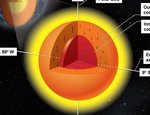The Earth’s inner core has another core, an inner-inner core inside it, and the iron crystals in both inner and inner-inner cores align differently, researchers from the University of Illinois and Nanjing University in China reported.
The researchers say that seismic waves are helping them learn more about our planet’s inner core. Thanks to a new technology, they have found that both inner cores have surprising properties that may reveal information about the Earth.
Study leaders, geology professor Xiaodong Song, who works at the University of Illinois, and post-doctoral researcher Tao Wang, and colleagues published their findings in the academic journal Nature Geoscience (citation below).

The earth’s inner core has an inner-inner core inside it, with crystals aligned in different directions. (Image: University of Illinois)
Prof. Song said:
“Even though the inner core is small – smaller than the moon – it has some really interesting features. It may tell us about how our planet formed, its history, and other dynamic processes of the Earth. It shapes our understanding of what’s going on deep inside the Earth.”
Much like medical professionals use ultrasound to see inside their patients, geologists use seismic waves from earthquakes to scan beneath the planet’s surface.
The scientists used a technology that collects data not from the first shock of an earthquake, but from the resonating waves in the tremor’s aftermath.
An earthquake’s jolt is similar to a hammer striking a bell, after the initial gong we continue hearing a clear tone that resonates. Seismic sensors gather a coherent signal in the earthquake’s coda (the total length of the seismic wavetrain).
Prof. Song said:
“It turns out the coherent signal enhanced by the technology is clearer than the ring itself. The basic idea of the method has been around for a while, and people have used it for other kinds of studies near the surface. But we are looking all the way through the center of the earth.”
They discovered there are two inner cores
When the scientists looked through the core they were surprised. The inner core, once believed to be a solid ball of iron, has some complex structural properties.
They found a distinct inner-inner core, about half the size of the whole inner core. The iron crystals in the inner core aligned directionally north-south, while those of the inner-inner core pointed roughly east-west.
Not only do the iron crystals in the two cores align differently, they also behave differently, suggesting that the crystals in the inner-inner core may be of a different type, or a different phase.
Prof. Song said:
“The fact that we have two regions that are distinctly different may tell us something about how the inner core has been evolving. For example, over the history of the earth, the inner core might have had a very dramatic change in its deformation regime.”
“It might hold the key to how the planet has evolved. We are right in the center – literally, the center of the Earth.”
The study was funded by the National Science Foundations of both China and the US.
Citation: “Equatorial anisotropy in the inner part of Earth’s inner core from autocorrelation of earthquake coda,” Tao Wang, Xiaodong Song & Han H. Xia. Nature Geoscience. Published online Feb 9, 2015. DOI:10.1038/ngeo2354.

